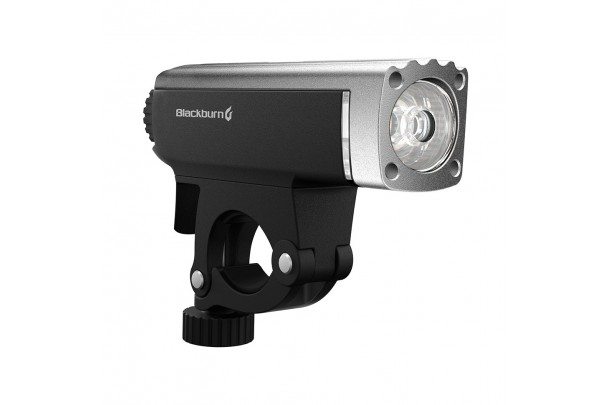Front Lights:
Blackburn Central Front Light

MSRP: $119
Blister’s Measured Weight:
- Light: 133 grams
- Mount System: 41 grams
- Total: 174 grams
Lumens: 500
The Blackburn Central features and low light settings, a strobe function as well as a “smart” setting. The “smart” setting varies light output intensity according to ambient light levels. The light is detachable from the screw-tightened, lever-based handlebar mount.
Pros: Smart setting extends battery life substantially, though the battery savings vary based on the amount of streetlights on your bike route. If, for example your route has many streetlights, the Central can last weeks on a single charge. If your route is poorly lit the battery life will be around the 1.5 hours for the 500 lumen setting. The Central’s mode selector is a dial instead of a button. This resulted in better tactile feedback while wearing gloves and it also makes the Central the easiest light in the group to turn off quickly.
Cons: The charge status indicator is qualitative instead of quantitative, so while it is easy to tell when battery power is below 25% the Central can still die unexpectedly when running low.
Overall: The Blackburn Central is a simple light with adequate lumens and impressive “smart” setting to extend battery life.
Blackburn Scorch 1.0

MSRP: $69
Blister’s Measured Weight:
- Light: 129 grams
- Mount System: 23 grams
- Total Weight: 151 grams
Lumens: 200
The Scorch 1.0 is a aluminum body, 200 lumen front light with a high, low and strobe setting. The Scorch is basically a flashlight that comes with a handlebar mount. It operates via one button on the end of the light. It scrolls through the three settings and then to power off. It is also the only light in the review that uses a USB to proprietary charging connection, so don’t lose that cable…
Pros: This light is the only fully metal bodied light in the review. It feels very durable. It is a simple light that is intuitive to use. This light would be great to bring along for travel or camping because it is just as useful off the bike as on the bike. It is also very easy to remove the light from the handle bar mount.
Cons: The mount is a big detractor from the overall quality. It attaches to the bars with a pipe clamp type screw mechanism. The cradle for the light extends over the screw that tightens the mount. This means that the mount itself impedes the user’s ability to tighten the mount. Forget about trying to take the mount on and off with gloves on. While it is very easy to take the light on and off the mount I worry about the durability of the rubber strap.
Niterider Lumina 800 OLED

MSRP: $169
Blister’s Measured Weight:
- Light: 131 grams
- Mount System: 39 grams
- Total: 170 grams
Lumens: 800
The Lumina features 200, 400, and 800 Lumen settings as well as several strobe patterns. Quoted charging time varies by power amperage from 3-6 hours. It’s detachable from a strap type handle bar mount.
Pros: That is a lot of brightness. The 800 lumen setting makes this light capable in settings requiring more light than usual commuting. Numerous settings and strobe patterns available. The setting that combines a solid light beam with an intermittent strobe flash does add the safety factor of strobe for low light conditions. It has SOS and Beacon settings that would be useful in an emergency in the backcountry, good for mountain biking, but less important for urban use. The battery readout is intuitive and easy to read. It weighs the same as the Blackburn Central, but has 300 more lumens available. The mount has a very nice swiveling capability to make sure that the light is perfectly aligned to your direction of travel.
Cons: While the mount itself attaches very securely to the handlebar, the connection between the light and the mount is less trustworthy. The main issue rests in the fact that the light slides onto the mount from the front towards the back. This combined with the small plastic flange that secures the light to the mount means that it is quite possible to accidentally disconnect the light from the mount if the user tries to change settings while riding. Twice in the two weeks I used the light it fell off my bike while trying to change settings on the go. This problem is worse in cold weather. Just be sure to double check that the light is securely attached each time you use it.
Overall: Complex, powerful light that has a setting for every situation. The mount does detract from the overall quality of the light.
NEXT: Rear Lights
